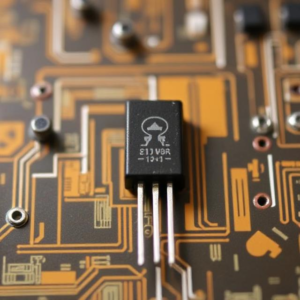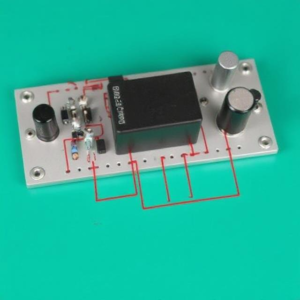A transistor amplifier is an electronic circuit that uses a transistor to increase the strength (or amplify) of weak electrical signals. Amplifiers are used in all sorts of devices. The transistor is key to this amplification process because it can control a large output signal with a small input signal.
There are several types of transistor amplifiers based on how the transistor is connected in the circuit.

Common Emitter Amplifier :
The common emitter amplifier is one of the most widely used BJT (Bipolar Junction Transistor) amplifier configurations. In this setup, the emitter is common to both the input and output signals (hence the name “common emitter”).
Key Features:
Voltage Gain: Common emitter amplifiers provide high voltage gain.
Phase Inversion: The output signal is inverted (it’s 180° out of phase with the input).
Moderate Current Gain: They provide good current amplification but not as much as a Darlington transistor.
Uses:
Audio amplifiers (e.g., in music systems or guitar amplifiers).
Signal processing (e.g., in radios, microphones).
Oscillators (in devices that generate sound).
Common Collector Amplifier (Emitter Follower)
What Is It?
The common collector amplifier is another BJT amplifier. In this setup, the collector is common to both the input and output, and the output is taken from the emitter.
How It Works:
The input signal is applied to the base of the transistor.
The output is taken from the emitter.
The collector is usually connected to the positive voltage supply.
The transistor amplifies the current, but the voltage gain is about 1, meaning it doesn’t change the size of the voltage much.
Key Features:
Voltage Gain = 1: The output voltage is nearly the same as the input voltage.
High Current Gain: The amplifier provides high current gain, which means it can drive loads that require more current.
No Phase Inversion: Unlike the common emitter amplifier, there is no phase inversion (the output signal follows the input signal).
Uses:
Buffer stages: To isolate circuits and match impedances.
Impedance matching: In applications where we need to transfer a signal from a high-impedance source to a low-impedance load (like headphones or speakers).
Common Base Amplifier
What Is It?
The common base amplifier is another BJT amplifier configuration. In this case, the base is common to both the input and output signals.
How It Works:
The input signal is applied to the emitter.
The base is typically grounded or held at a fixed voltage.
The output is taken from the collector.
The transistor amplifies the signal, but the output signal is not inverted.
Key Features:
Low Input Impedance: Common base amplifiers have low input impedance, meaning they don’t accept signals well from high-impedance sources.
High Output Impedance: They have a high output impedance, making them suitable for driving high-impedance loads.
Voltage Gain: It can provide good voltage gain, but typically, it’s not used for very high-frequency signals.
Uses:
High-frequency amplifiers: Often used in radio-frequency (RF) applications like radio transmitters and receivers.
Impedance matching: Useful in applications requiring impedance matching for high-frequency signals.
Common Gate Amplifier (FET Amplifier)
What Is It?
The common gate amplifier is a Field-Effect Transistor (FET) amplifier configuration. This is similar to the common base amplifier but for FETs instead of BJTs.
How It Works:
The input signal is applied to the source of the FET.
The gate is typically held at a fixed voltage or grounded.
The output is taken from the drain.
Like the common base amplifier, the common gate amplifier has low input impedance and is commonly used for high-frequency applications.
Key Features:
Low Input Impedance: Common gate amplifiers have low input impedance, which means they don’t accept signals well from high-impedance sources.
High Output Impedance: Like the common base amplifier, the output impedance is high.
Voltage Gain: It offers good voltage gain but is typically used in high-frequency applications.
Uses:
High-frequency amplification: In radio communication and other RF systems.
Impedance matching: Used in situations where impedance matching is important for high-frequency signals.
Differential Amplifier
What Is It?
A differential amplifier amplifies the difference between two input signals. It is typically made using two transistors.
How It Works:
The two input signals are applied to the bases of the two transistors.
The output is taken from the collector of the transistors.
It amplifies only the difference between the two input signals and rejects any signals that are the same (known as common-mode signals).
Key Features:
Amplifies Differences: Only amplifies the difference between the inputs.
Common-Mode Rejection: Rejects common-mode noise (noise that is present in both inputs).
Used in Operational Amplifiers: Differential amplifiers are the core of operational amplifiers (Op-Amps), which are used in a variety of applications.
Uses:
Op-Amps: Used in many analog signal processing tasks like filters, amplifiers, and signal conditioning.
Audio systems: For noise rejection in audio circuits (e.g., to reject hum and other unwanted noise).
Keywords: semiconductor, Electronics











